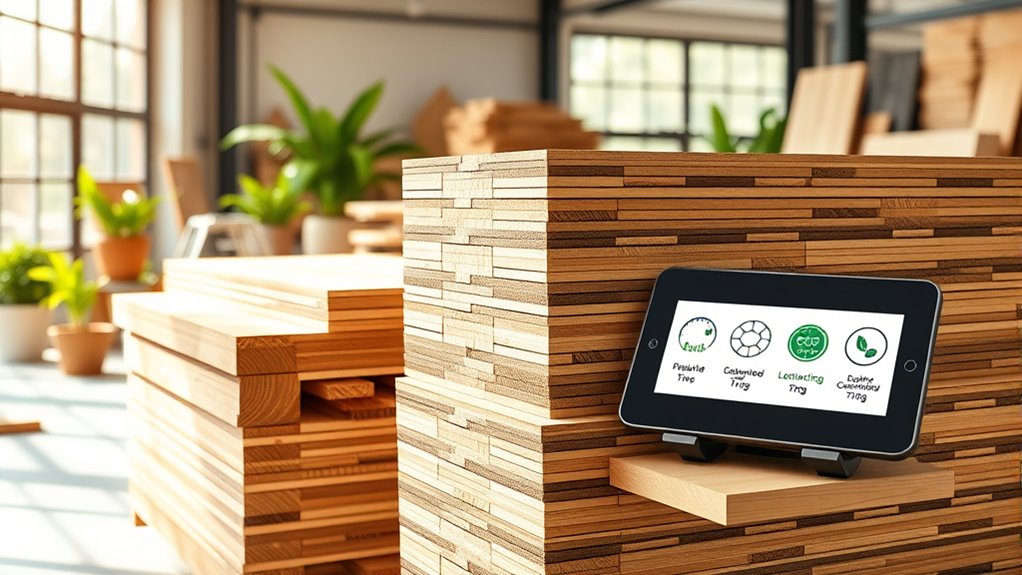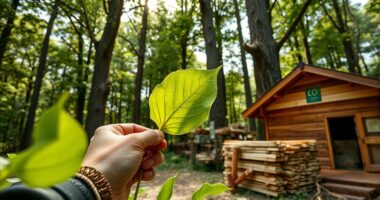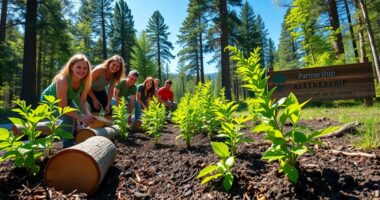For eco-friendly projects, choose sustainably harvested woods like fast-growing softwoods, including Douglas fir and loblolly pine, certified by organizations like FSC. Consider durable hardwoods such as cherry or oak from responsible sources, or explore engineered wood products made from renewable residues. Bamboo is another excellent choice because it matures quickly and absorbs plenty of CO₂. Incorporating reclaimed wood and verifying supplier practices guarantees responsible sourcing. Keep exploring to discover more about how to make eco-conscious decisions in your projects.
Key Takeaways
- Prioritize certified woods like FSC or PEFC to ensure responsible and sustainable forest management.
- Use fast-growing softwoods such as Douglas fir, slash pine, or spruce from managed plantations for renewable sourcing.
- Consider engineered wood products made from recycled and renewable materials to maximize resource efficiency.
- Incorporate bamboo, which matures quickly and regrows naturally, as a highly sustainable alternative to traditional hardwoods.
- Verify supplier sustainability practices through documentation and site visits to support eco-conscious sourcing.
Fast-Growing Softwoods for Sustainable Use

Fast-growing softwoods are essential for sustainable timber production because they can be replenished quickly through managed plantations. Conifers like Douglas fir, slash pine, loblolly pine, and spruce grow rapidly, enabling harvest cycles often under 30 years. This quick growth means you can continually replant and harvest without depleting forests, ensuring a steady supply. These species also enhance carbon sequestration, helping offset emissions during growth. Managed forests certified by organizations like FSC guarantee responsible practices, maintaining ecological balance. Softwoods from these fast-growing trees are strong, durable, and naturally decay-resistant, reducing the need for chemical treatments. They support eco-friendly projects by providing renewable, low-impact timber options that align with sustainability goals and promote environmental health. Additionally, understanding the growth rates of these species helps optimize harvest schedules and sustainability efforts, which is vital for sustainable forestry practices. A thorough knowledge of growth cycles can further improve management strategies, ensuring long-term ecological and economic benefits. Recognizing the importance of responsible forestry reinforces efforts to balance ecological health with economic viability in timber management. Moreover, selecting species with predictable growth patterns can streamline planning and resource allocation for forest managers and investors alike.
Hardwoods With Eco-Friendly Credentials

Hardwoods with eco-friendly credentials offer a sustainable alternative to traditional timber, ensuring that your projects support environmental health. These hardwoods are renewable resources, meaning you can harvest them responsibly while allowing forests to regenerate. They are naturally durable and resistant to decay, reducing the need for chemical treatments, which benefits indoor air quality. Choosing certified woods, like FSC or PEFC, guarantees your material comes from responsibly managed forests. Sustainable forestry practices help maintain ecosystem balance and ensure ongoing forest productivity. Popular options such as cherry, maple, walnut, white oak, and redwood not only boast beautiful aesthetics but also support local economies and promote forest health. By selecting these sustainable hardwoods, you contribute to carbon sequestration efforts, helping combat climate change, while ensuring your project aligns with environmentally sound practices. Additionally, understanding and managing risks in merchant services can help ensure your sourcing processes remain secure and compliant.
Engineered and Processed Wood Products

Engineered and processed wood products offer a sustainable alternative to traditional timber by maximizing resource efficiency and minimizing environmental impact. They store carbon, helping reduce the overall carbon footprint of buildings, and require less energy during manufacturing, lowering emissions. Additionally, these products are often manufactured with weather-resistant materials, enhancing their durability and suitability for various outdoor applications. Made from renewable resources like small-dimension lumber and wood residues, these products promote sustainable harvesting and reduce deforestation. They also minimize waste through precise, consistent manufacturing, allowing for custom lengths and pre-cut options that cut construction waste. Using engineered wood supports green building certifications like LEED, contributing to energy-efficient, low-impact structures. Advances in manufacturing, such as low-emission adhesives and tailored designs, further enhance their eco-friendliness. Furthermore, innovations in manufacturing processes have led to improvements in sustainability metrics, making these products an even more attractive choice for environmentally conscious projects. Incorporating sustainable harvesting practices in sourcing materials ensures the ongoing availability of renewable resources, reducing the pressure on natural forests. Additionally, ongoing research in sustainable materials development continues to improve the environmental performance of engineered wood products.
Bamboo as a Renewable Material

Have you ever considered how bamboo’s rapid growth makes it a truly sustainable resource? It reaches maturity in just 3–5 years, unlike hardwoods that take decades. Since bamboo regrows from existing roots after harvesting, no replanting is necessary, and it can be harvested annually without damaging ecosystems. Its high yield—producing 20 times more material per hectare than traditional forests—reduces land use impacts. Grown across Asia, Africa, and the Americas, bamboo cuts transportation emissions and ensures global availability. Plus, it absorbs up to 12 metric tons of CO₂ per hectare each year, outpacing many trees. Its biomass generates organic material efficiently, and it requires less energy to process than steel or concrete. With natural fire resistance and strength comparable to steel, bamboo offers a versatile, eco-friendly alternative for sustainable projects. Sustainable harvesting practices help maintain bamboo’s ecological benefits and ensure ongoing productivity. Moreover, its carbon sequestration capacity makes it an outstanding choice for combating climate change, especially when combined with reforestation efforts. Additionally, advances in bamboo processing technology are making it even more practical for a wider range of applications. Furthermore, certification standards are emerging to promote sustainable bamboo cultivation and use.
Best Practices for Eco-Conscious Sourcing

Choosing sustainable wood sources requires more than just selecting eco-friendly materials like bamboo; it involves implementing responsible sourcing practices. Start by prioritizing certified wood from organizations like FSC or SFI, which guarantee your wood is harvested sustainably and without harming protected forests.
Always vet your suppliers by requesting documentation and conducting site visits to verify their practices. Establish long-term relationships with suppliers who share your sustainability values to improve traceability and consistency.
Incorporate reclaimed wood whenever possible to reduce deforestation and waste. Educate your team on sustainable sourcing principles, emphasizing the importance of understanding a product’s entire life cycle—from harvesting to disposal. Additionally, understanding the supply chain of your wood can help identify areas where sustainability can be improved.
These practices help you make environmentally responsible choices that support biodiversity, reduce impact, and meet consumer demand for ethical products.
Frequently Asked Questions
How Do Different Wood Treatments Affect Environmental Sustainability?
Different wood treatments impact environmental sustainability mainly through chemical leaching and toxicity. When you choose chemically treated wood, chemicals like arsenic, chromium, and copper can leach into soil and water, harming ecosystems.
These treatments can also pose health risks to you and nearby residents, especially with prolonged exposure. To minimize environmental harm, always follow treatment standards, handle wood carefully, and consider alternative, less toxic preservatives.
What Certifications Guarantee Responsible Forestry Practices for Wood Products?
Think of certifications like a lighthouse guiding you through a foggy sea. They guarantee responsible forestry practices by ensuring wood comes from well-managed forests.
The FSC certifies global forests with strict environmental and social standards, while the SFI focuses on North American forests with independent audits.
The PEFC endorses national schemes, promoting ecological, social, and economic sustainability.
These certifications verify that your wood products support responsible forest management and protect our planet.
How Does Transportation Impact the Overall Eco-Footprint of Wood Sourcing?
Transportation considerably impacts your wood sourcing eco-footprint by adding roughly 20% of greenhouse gas emissions in some supply chains. Diesel trucks dominate, releasing CO₂ throughout harvesting and processing.
Choosing regional sources, optimizing routes, and using low-impact modes like rail or marine transport can lower these emissions.
Lighter species and local sourcing make transport more efficient, helping you reduce your environmental impact and support more sustainable forestry practices.
Can Reclaimed or Recycled Wood Meet Modern Durability Standards?
Did you know old-growth reclaimed wood is up to 40 points harder on the Janka scale than new wood? This means it can meet or even exceed modern durability standards.
You can trust reclaimed wood’s density and strength, especially when properly sourced and finished. With rigorous inspection and quality assurance, reclaimed or recycled wood offers a sustainable, durable option that adds character and longevity to your projects.
What Are the Long-Term Environmental Benefits of Engineered Wood Options?
You want to know the long-term environmental benefits of engineered wood options. Engineered wood stores carbon naturally, helping reduce overall emissions. It uses resources efficiently, minimizing waste, and is made through low-energy processes that lower environmental impact.
Over its life cycle, it’s renewable, supports sustainable forestry, and often meets green building standards. Choosing engineered wood means you’re contributing to climate change mitigation and promoting eco-friendly practices in construction.
Conclusion
By choosing sustainable woods, you become a steward of Earth’s lush tapestry, weaving projects that honor nature’s delicate balance. Like a gentle breeze guiding a leaf, your eco-conscious choices ripple outward, nurturing forests and future generations. Embrace these renewable materials as your trusted allies, transforming your craftsmanship into a symphony of responsibility. With every mindful selection, you help cultivate a greener world—where beauty and sustainability dance in perfect harmony.









